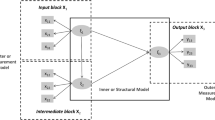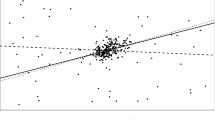Abstract
The approach to dynamic modeling with latent variables has been developed on the base of H. Wold’s partial least squares (PLS). The original PLS estimation algorithm is virtually applicable. In addition to that lagged and leaded latent variables are used in the iterative process of estimating the weights of the manifest variables. The path coefficients are estimated by OLS. A redundancy coefficient allows to measure the forecasting validity. Finally the algorithm has been programmed in XploRe .
Access this chapter
Tax calculation will be finalised at checkout
Purchases are for personal use only
Preview
Unable to display preview. Download preview PDF.
Similar content being viewed by others
Bibliography
Geppert, F. (1996). Bearbeitung, Programmierung, Simulation und Anwen-dung eines PLS-Algorithmus für einfache dynamische Modelle mit latenten Variablen. Diploma thesis supervised by H. G. Strohe, Universität Potsdam.
Härdle, W., Klinke, S., and Turlach, B. A. (1995). XploRe: An Interactive Statistical Computing Environment. Springer-Verlag, Berlin.
Jöreskog, K. G. and Sorbom, D. (1987). LISREL VII Program Manual. International Educational Services, Chicago.
Lohmöller, J.-B. (1984). LVPLS 1.6-Program Manual (Latent Variables Path Analysis with Partial Least Squares Estimation). Zentralarchiv für empirische Sozialforschung, Universität Köln.
Lohmöller, J.-B. (1989). Latent Variable Path Modelling with Partial Least Squares. Heidelberg.
Strohe, H. G. (1995). Dynamic Latent Variables Path Models-An Alternative PLS Estimation. Statistische Diskussionsbeiträge Nr. 1, Universität Potsdam.
Strohe, H. G. and Geppert, F.(1997). DPLS-Algorithmus und Computerprogramm für dynamische Partial-Least-Squares-Modelle. Statistische Diskussionsbeiträge Nr. 7, Universität Potsdam.
Wold, H. (1973). Nonlinear Iterative Partial Least Squares (NIPALS) Modelling—Some Current Developement; in P. R. Krishnajah (Ed.), Multivariate Analysis (Vol. 3, p. 383–407), New York; Academic Press.
Rights and permissions
Copyright information
© 2000 Springer-Verlag Berlin Heidelberg
About this chapter
Cite this chapter
Geppert, F., Strohe, H.G. (2000). DPLS—Partial Least Squares Program for Dynamic Path Models. In: XploRe® — Application Guide. Springer, Berlin, Heidelberg. https://doi.org/10.1007/978-3-642-57292-0_11
Download citation
DOI: https://doi.org/10.1007/978-3-642-57292-0_11
Publisher Name: Springer, Berlin, Heidelberg
Print ISBN: 978-3-540-67545-7
Online ISBN: 978-3-642-57292-0
eBook Packages: Springer Book Archive




